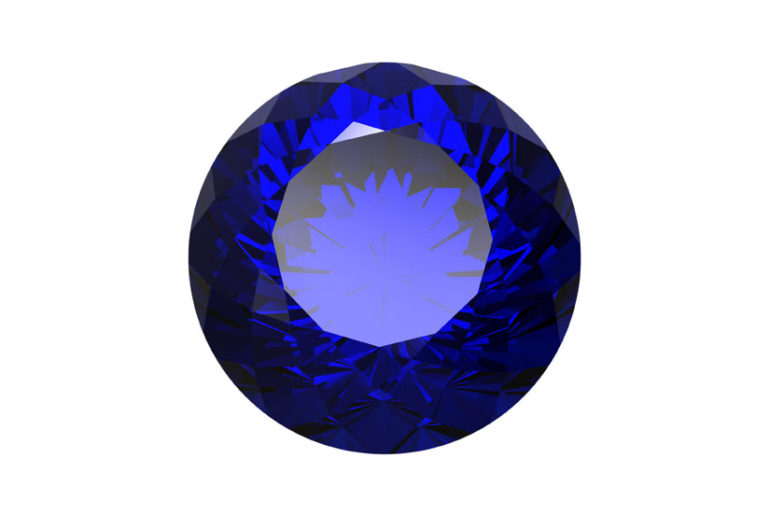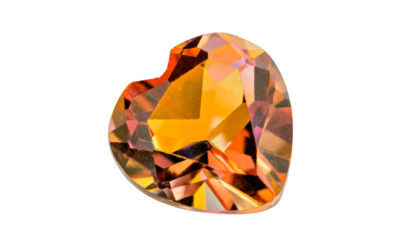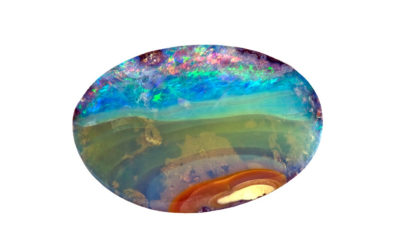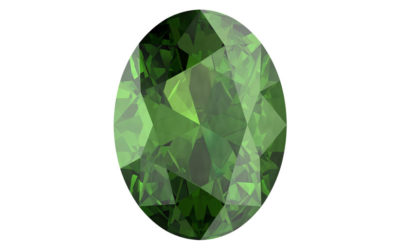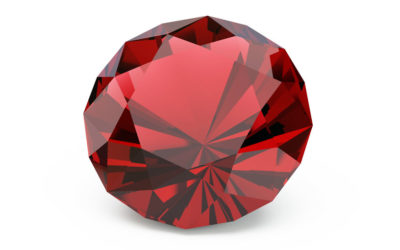September is a month that people either love or loath to end–it all depends on what’s their favorite season! The month ushers in the last days of summer and the first days of fall. September, as a word, can be traced back to Old English when it was called Haervest-monath, which means “Harvest Month.” This makes sense when you think about the ripening of so many fruits and vegetables before the cold season eventually kicks in.
The month of September is also tied to the Latin root septem, which means “seven.” It used to be the seventh month on the early Roman calendar. Seven is a sacred number in many cultures. For instance, in the Christian Bible, the world was created in seven days; there are seven archangels in Revelation at the end of the world. One can argue that the sacred nature of the number channels into September, making it the perfect month for the unique gemstone, the sapphire.
The gem is said to help one’s mind gain focus, which in turn heightens one’s ability to connect with the higher powers and increase the wearer’s self-discipline.
Sapphire is a gem of many colors
The first color that comes to mind when someone thinks of the gem is blue. Blue is actually one of the gem’s many colors. The birthstone is arguably one of the most diverse birthstones when it comes to color. The royal blue that we know it for is common, but the only color that isn’t represented by the gem is red, which is categorized as a ruby. September babies have a rainbow of color options to choose from and connect with.
The gemstone is a variety of the mineral corundum. They contain elements such as magnesium, copper, chromium, titanium, and iron. Corundum is naturally colorless, but the minerals are what give it the tint. Magnesium makes it green; copper makes it orange; chromium turns it purple; lastly, corundum turns it blue. The ones that aren’t blue are known by the term “fancies.”
The pink sapphire vs the ruby
The pink sapphire is known for being the most interesting of the different shades of the gem because they tend to blur the lines that keep rubies and the September birthstone separate.
In the United States, the birthstone must meet a minimum color saturation test to categorize as a ruby. The spectrum isn’t just pink and red. In between are some interesting shades such as the “padparadscha.” The word comes from the Sri Lankan term for “lotus flower.” It contains a pinkish-orange tint. At times, this variant can actually go for a higher price than that of the blue sapphire. (September Birthstone)
The meaning of “sapphire”
In Greek lexicon, sapphire comes from sappheiros, and in Latin, sapphirus. Both of them mean “blue stone.” Originally, the words were considered descriptors for the lapis lazuli. Some scholars believe that the word or its representation may be linked to the Sanskrit term “sanipriya,” which means “dear to Saturn.”
Where are sapphires located
The birthstone is found in North America–mainly in Montana, Africa, Brazil, Australia, China, Sri Lanka, Vietnam, Thailand, India, and Myanmar. The places where they’re found can affect their value, clarity, color, cut, and carat size.
How hard is a sapphire?
The gem has one of the hardest surfaces according to the Mohs scale. With a measurement of nine, it is second only to the diamond. Its hardness has made it valuable not only as an accessory, but valuable to industrial applications such as high-durability windows, watches, instruments, and electronics.
The history of the sapphire–part one
The September gem has had a long history. It’s been popular since the Middle Ages. At that time, they looked upon the blueness of the gem as representative of divinity. This is, perhaps, why we see the color pop up in various places in the Bible. Blue being celestial, like the sky, is symbolic of heaven, which made the gem famous for bringing the wearer divine favor and helped them make wise judgments.
In Greek culture, people wore the gem for guidance when they heeded prophecies from an oracle. The Buddhists believe that the gem brought people spiritual enlightenment. The gem was also used by the Hindus for worship. The gem was cherished by early Christian kings as well. They wore them for their believed power of protection. The gem was put on ecclesiastical rings.
The history of the sapphire–part two
In ancient times, the chosen people believed that the Ten Commandments were engraved on tablets made of the birthstone. But since then, historians, now, are convinced that the blue stone referred to in the Bible was actually a lapis lazuli.
Traditionally coming from the Kashmir region of India between the late 19th and early 20th century, the classic deep blue gem was said to have been mined there for quite some time. As a matter of fact, the world record for price-per-carat for the gem was set by one that came from the location. It sold at an auction for around $242,000 per carat! This put it in the $7 million range. The record was made in October 2015.
Some of the sapphires are very popular
One of the most popular versions of the gem is the star sapphire. Ranging in the 1404.49-carat range, the Star of Adam is a favorite. So is the Star of India, coming in at 563.4-carats. The Star Ocean Bombay, at 182-carats, came from the Sri Lankan mines as well as the other two.
If you wanted to find the gem, chances are, you went to Australia to get them. That is until they were discovered in Madagascar in the 1990s. Today, it is still considered the leading place in the world to find and produce the gem.
The synthetic sapphire
Synthetic versions of the birthstone were developed in 1902 for the first time by Auguste Verneuil, a French chemist. The creation of a synthetic gem helped to bring forth the industrial applications of things like the spanning of integrated circuits, high-durability windows, satellite communication systems, and scientific instruments.
The history of the sapphire—part three
The birthstone became a representation of royal love when, in 1981, British Royalty, Prince Charles gave Lady Diana a 12-carat royal blue variety of the gem as an engagement ring. Later on, the same would happen with Prince William who had given a ring to Catherine Middleton in 2010 when he proposed to her. (Ring of Contempt)
Birthstone enthusiasts should keep in mind that even though the blue variety of the gem is the most common version, the gem itself is rare. Even more so rare is the top-quality version of the blue variant. This makes the blue variety a bit of a paradox!
Sapphires follow the 4 Cs
The gem is ideal for celebrating the fifth or even a forty-fifth wedding anniversary. Regardless of what you would buy it for, it makes a great gift.
The gem is up there with the diamond, and, as such, is assessed by the 4 Cs: carat size, cut, clarity, and color. The country of origin also factors into the overall value.
The color of the gem is one of the main things that with tell you its price. The most valued version is the purest of blues, but, sometimes, the ones with a violet hue are valued as well.
Secondary shades of green or gray aren’t favored. Some buyers believe that these hues detract from the gem’s beauty. However, that is relative. It is up to the individual buyer to consider it true or not.
Sapphires can “change colors”
Another phenomenon that makes the sapphire a fascinating gem is its ability to color change. It shifts from blue in daylight or fluorescent light to reddish purple under an incandescent light. This is similar to alexandrite and can add dimension to the overall presentation of the gem. The color is even more radiant given how the clarity of the gem is higher than other gems like the ruby.
Some gems have what are called “silks,” long and thin rutile inclusions. Generally speaking, they could lower or increase the value of the gems. This is especially true if it exhibits asterism.
The blue sapphire
The blue variety of the birthstone can range in size from just a few to a hundred or more carats.
The average commercial-quality version is less than five carats. When compared to larger rubies, the blue variety is still more readily available. The National Museum of Natural History has one of the largest faceted gem-quality blue varieties known. It comes in at 423-carats and is known as the Logan Sapphire.
The prize for largest blue sapphire, however, goes to The Star of Adam, which comes in at 1409.49 carats! Calling this one rare is an understatement.
Are sapphires treated?
The birthstone is treated with heat in order to improve the color and clarity of the cut. The ones that aren’t treated are far more valuable but are also quite rare.
The lore and stories behind the sapphire–part one
One piece of lore about the gem comes from the Far East. More than two millennia into the past, there were a people called the Khmer who lived in what was once called Burma but is now known as Myanmar. The biggest temple they had created was made in dedication to Tsun-Kyan-Kse, their golden goddess who had two sapphire blue eyes.
The lore says that inside the temple, under her protection, there lived black and brown temple cats. One of them was named Sinh, his hair was dark brown. He was known as the devoted pet of the Grand Lama, Mun-Ha. One night, while the Grand Lama was alone in prayer, Thai invaders attacked the temple. The Grand Lama was sadly killed in this attack.
Sinh, ever faithful, placed his paws on his master’s body and lifted his gaze up towards the statue of the beloved goddess, located in the center of the temple. Instantaneously, there was a transformation. Sinh’s dark fur shined into a golden hue and his eyes pierced the dark with a sapphire blue tint.
The magic that took over the cat was so powerful that it pushed the invaders away. They never did return. This legend is believed to be the reason why the Birman cat is known for having a sapphire-blue gaze.
The tale also reinforces the symbolism of blue as celestial and divine. The gem, the ancients believed, had the power to keep them safe. It made the Birman cat a beloved breed. (Sapphminco: Fine Sapphire)
The lore and stories behind the sapphire–part two
During ancient times, astrologists believed that the birthstone had healing powers. It was considered to bring forth truth, wisdom, clear thinking, and loyalty.
Its powers were heightened when it was worn by someone who was born in September or born under the zodiac sign Virgo. Depending on how you break down the dates of a Virgo, those who aren’t born in September may also (technically speaking) have the gem represent them!
The power of healing also extended to curing physical ailments like eye infections, earaches, headaches, and thyroid problems.
It is believed that in Europe, the power of literature helped raise the popularity of the gemstone. The story goes that in the 18 th century, a very popular French author named Madame de Genlis wrote a story titled Le Saphir merveilleux, known in English as “The Marvellous Sapphire.”
Due to the popularity of the story, many people began to don the gem on their person, especially those who were included among the wealthy couples of Europe.
The birthstone is tough to find and tough in general. In order to find it, tons and tons of earth are shifted about. This is one reason why they’re so durable and resilient. It is also why many people tend to use them for engagement rings. They have strength in them that will last a lifetime. The same could be said as the blessing one would want in their engagement — for their love to last a lifetime.
Even in Rome and Greece, where they were cultural symbols of truth and loyalty, we see this sentiment echoed throughout time.
Rough versions of the gem tend to not glow as much as the polished ones we see on people as jewelry. They’re very dark and quite dull actually.
Regardless of where the story comes from, it can’t be denied that the September birthstone has left an everlasting impact on many different societies. It makes a lasting gift and is great in any and all occasions. It’s a great start to an autumn season, and September babies should be proud!
References
The Sun. “RING OF CONTEMPT Why Princess Diana’s sapphire engagement ring was SO controversial at the time” TheSun.co.uk, www.thesun.co.uk/fabulous/7029115/princess-diana-engagement-ring-controversial/ (accessed November 29, 2018)
Sapphminco. “Sapphminco: Fine Sapphire from Australia and Laos” Sapphminco.com, www.sapphminco.com/sapphire-story.php (accessed November 29, 2018)
GIA. “September Birthstone: What You Need to Know About Sapphire” GIA.edu, 4cs.gia.edu/en-us/blog/september-birthstone-sapphire/ (accessed November 29, 2018)

